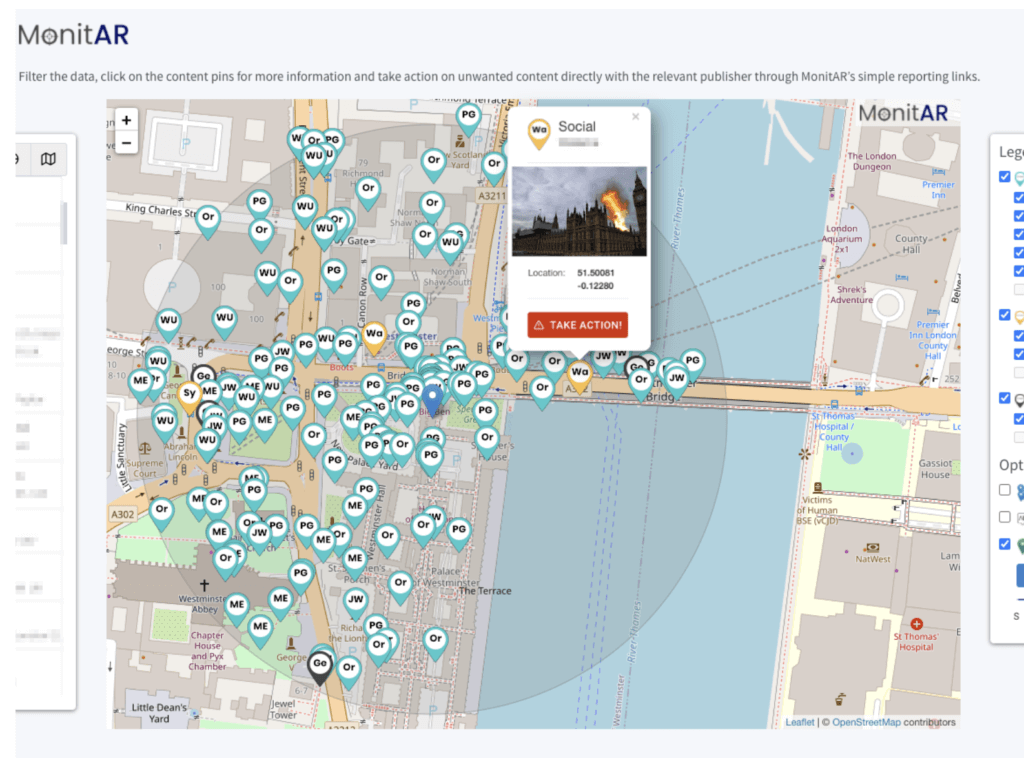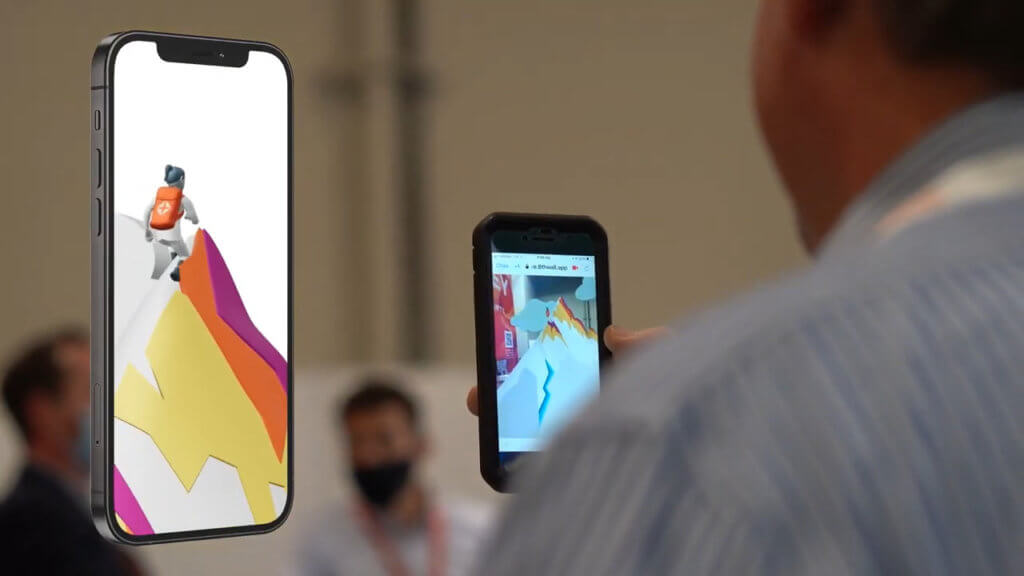Everybody wins in the world of XR brand engagement. Brands get a unique and dynamic way to interact with customers. Customers get fun and informative ways to interact with their favorite brands. And the rest of us? The most cutting-edge advances in AR graphics and dynamic rendering that will one day build games and other apps are being developed by AR advertisers.
Here, we’ll look at some of the most exciting AR brands and brand engagements. We’ll look at their advertising content and programs, but we’ll also talk about the other implications that these use cases have for AR technology in general.
LBEs
Location-based experiences are the future. We’re talking about going to a specific place and having that location augmented by information and assets specific to that geographic location.
Brand engagement experiences and LBEs aren’t always one-to-one, as most of the examples that this article looks at can be launched anywhere that an image target or QR code is located. However, as we’ll see, in-store and on-site AR experiences often come out of promotion or retail considerations.
8th Wall
This summer, 8th Wall released their 17th major platform update, which expands world effects with a focus on AR portals. These portals open up new virtual worlds for users to walk through or otherwise interact with. Once a portal has been opened, the user needs only to walk through it to enter a 360-degree virtual environment.

Because 8th Wall is based in WebAR, developers point out that multiple portal destinations can be linked together to create a “multiverse experience.”
Zappar
The London-based Zappar agency is working with portals too. They play into a recent brand engagement experience that the organization created for LEGOLAND at Windsor Resort location.
Much of the magic of these places comes from visiting the resort itself. However, visitors can access these portals through an app to revisit the magic of LEGOLAND once they have returned home.
MVP Interactive
We’ll talk about MVP Interactive again later in the article when we talk about developments in targets and targeting for AR experiences. MVP specializes in working with sports and athletic brands, and many of their brand engagement experiences take place in and around physical locations using iconic elements of these locations as launch-points for the experiences themselves.
Darabase
Darabase handles location-based experiences differently. They work with property owners and managers (primarily in the London area and the UK). Most of their experiences have been related to art and culture rather than to retail and brand engagement, but their application has a lot to do with AR experiences more broadly.

Property owners and managers that work with Darabase can see all of the location-based experiences on their land – including experiences that they don’t sanction and wouldn’t otherwise know about. This can allow them to respond to AR artefacts posted by bad actors, even by competitors.
ARIA Network
The ARIA Network does similar work to Darabase, but working in the United States. Further, while Darabase typically works with creative agencies like Zappar, ARIA has an internal creative team. ARIA is also more likely to do brand engagement experiences than art and culture.
Where Darabase manages virtual property by alerting property owners and managers of potential unwarranted AR experiences, ARIA secures “Virtual Air Rights” with its partners. This is a field of property law that is still being written, but it is likely something that we’re going to be seeing a lot more of going forward.
Hovercraft
Hovercraft has its own solution for location-based experiences. Their AR brand engagements take place within “geofenced microsites.” This ties the virtual experience to the physical location like all of these solutions, but it doesn’t necessarily solve the problem of unwanted AR experiences from other sources, like Darabase and ARIA do.
The company recently worked with Nike Paris and NYC House of Innovation this year on an AR on-site product launch of the ACG HO20.
Graphics and Rendering
AR gaming companies like Niantic, and social AR companies like Snapchat are behind a lot of the advances happening in mixed reality graphics and asset rendering, as are enterprise applications. However, advertising and retail, perhaps more than any other industry, pursue a seamless blending of virtual objects with the physical space.
Blippar
Blippar blew our minds with their virtual product launch of the Nord OnePlus phone in 2020. The event featured a volumetric capture of OnePlus staff viewed by over 7.5M viewers, according to CEO Faisal Galaria.
“It was as close as you could get to actually being there and, arguably, it was more scalable,” Galaria told ARPost in an interview at the time.
8th Wall
8th Wall has used holograms in brand engagement experiences as well, with the most recent being a July WebAR game featuring a hologram of tennis champion Andy Murray. 8th Wall also recently worked with Powster to create an AR experience for the horror film “Candyman” that was launched by a user speaking a phrase from the film into their phone.
“We’re excited to bring the anticipation and adrenaline rush of ‘Candyman’ to life online, immersing audiences in the world of urban legends and creative storytelling,” Powster CEO and Creative Director, Ste Thompson, said in a release shared with ARPost.
Targets and Targeting
XR brand engagement experiences that require target recognition encourage users to interact with objects, or to bring virtual spaces within physical spaces. Targeting for AR experiences used to mean QR codes. While QR codes are still in use and have a number of benefits, AR experiences can also now be launched from recognizing images and other visual elements.
MVP Interactive
As mentioned earlier, MVP Interactive specializes in brand engagement for athletic retailers and sports teams. The company does work with other big-name brands including AT&T, Samsung, Chase, USAA, Pepsi, and Coke.
What most of these brands have in common is that they offer an experience rather than a product. And, according to MVP Interactive CEO James Giglio, that’s what people want.
“From a human psychology, or at least market study perspective, with the millennial generation compared to generations before them, the experience becomes more important than the product,” Giglio told ARPost in a call last year. This bodes well for XR. “The younger generation has been primed for this kind of interaction… an entire generation built on that experience.”

When we talked to MVP last year, the company had just worked on the AR layer of a mural in Nashville Tennessee. More recently, the company created a QR-launched experience with Waystar. The experience launched from one of three QR codes located around an expo booth, each bringing users to a unique brand engagement experience.
8th Wall
The thing about QR codes and many other XR triggers is that they have to be scanned while flat. In terms of marketing and brand engagement, a lot of things are not flat. 8th Wall pioneered image and target tracking that could work without viewing the whole image or target, making way for experiences based around curved objects.
This can and does work for wine bottles and soda cans, but as developers explained, it could also work for targets placed on light poles, or any similar scenario.
Zappar
As we’ve seen, Zappar works with individual brands, but the company also transcends brands by partnering with packaging companies. In May of 2020, the AR powerhouse partnered with Solucan, a Canadian beverage packaging company.
More recently, the company’s experience building toolkit ZapWorks began powering a unique sales tool for Jokey, a manufacturer of plastic tubs for various products and distributors. The company sends a bucket to prospective clients and the bucket serves as a target showing what Jokey is capable of. One day, they might forgo physical buckets.
“With our smartphones, the world is becoming more connected, communicative, and – through various channels, interactive,” Jokey’s Project Manager of Digitization Timo Domian said in a release shared with ARPost. “Packaging could offer so much for all consumers during its physical lifecycle, much more than traditional packaging today.”
MetaVRse Is Its Own Category
MetaVRse can do a lot of the things that we’ve seen in some of the use cases detailed above – probably their biggest offering is their engine for creating assets and experiences from CAD models. Other experiences by this company could have been, and probably should have been, detailed above. But, all that we can think about are MetaVRse virtual showrooms.
“When we built the first virtual showroom, it took maybe three or four days, and it was just a proof of concept,” MetaVRse Co-Founder and CEO Alan Smithson told ARPost in a remote interview. “These ‘Vstores’ are very experimental right now, but as soon as this clicks, every brand jumps on.”
The virtual showroom is a complete virtual space that can be navigated with WASD controls on a keyboard, or using a digital joystick interface on a mobile device. The space is populated with three-dimensional models of products or art pieces ranging from physical sneakers and watches to completely digital NFTs.
“We’re at the point where brands viscerally understand the word ‘metaverse,’” said Smithson. “Brands are already pushing the envelope on what’s possible in these virtual worlds.”
So far, virtual showrooms have been used principally by automotive companies to showcase models. However, the kind of virtual store that MetaVRse is making possible – where users can navigate a virtual world to both view and purchase models of physical items from a variety of different retailers, is completely novel.
More than that, the MetaVRse low-code interface means that companies that leverage it can develop their own brand engagement spaces and experiences.
From Any Angle, This Is Big
Depending on your personal views on commerce (and particularly e-commerce), retail, advertising, and brand engagement may or may not be your favorite conversation in XR. However, while the hardware and the market develops for more entertaining applications, companies like those discussed above are pioneering the software for those experiences.
On the other hand, if you are most interested in brand engagement topics in XR, there’s so much to talk about. The ways that brands reach, interact with, and learn from the public is more dynamic and promising than it ever has been.




